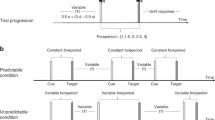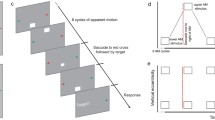Abstract
We are faster to orient our eyes toward a visual target that also produces a sound. Conversely, the response to an auditory target is prolonged if a visual distractor is presented at a spatially incongruent position. Here, participants exhibited faster saccadic reaction times when an auditory target was more likely to be presented opposite to a visual distractor than when the stimuli only rarely occurred in spatial disparity. In contrast to experiments with visual targets and an auditory distractor, a spatially congruent visual distractor did not facilitate the response to an auditory target. We interpret the results in terms of an ocular inhibition process to suppress an automatic orienting response to the location of the visual distractor. This process is shown to be modulated by the predictability of target location.

Similar content being viewed by others
Notes
The spatial congruence effect of 45 ms reported here diverges slightly from the difference between the spatially incongruent and congruent conditions reported in the first paragraph (223–182=41 ms) due to different numbers of observations in each analysis. In the second paragraph, the raw data of each subject was averaged for SOA, spatial congruence, and ISC and then submitted to the ANOVA for repeated measurements, while in the first paragraph the bimodal raw data was only averaged for spatial congruence.
Following the suggestion of a referee, we reanalysed the SRT differences between the three incongruent conditions while reducing the number of observations in the 50% and 80% predictability conditions by random selection to n=250, as in the 20% condition. Pairwise contrasts between the three levels of predictability in the incongruent condition again revealed significantly shorter mean saccadic reaction times (SRT) in the 80% than in the 20% condition (F (1,4)=7.91, P<0.048) and marginally longer mean SRTs in the 20% condition compared to the 50% condition (F (1,4)=6.71, P<0.061).
References
Carlson KA, Flowers JH (1996) Intentional vs unintentional use of contingencies between perceptual events. Percept Psychophys 58:460–470
Colonius H, Arndt P (2001) A two-stage model for visual-auditory interaction in saccadic latencies. Percept Psychophys 63:126–147
Corneil BD, Munoz DP (1996) The influence of auditory and visual distractors on human orienting gaze shifts. J Neurosci 15:8193–8207
Corneil BD, Hing CA, Bautista DV, Munoz DP (1999) Human eye-head gaze shifts in a distractor task. I. Truncated gaze shifts. J Neurosci 82:1390–1405
Corneil BD, van Wanrooij M, Munoz DP, van Opstal AJ (2002) Auditory-visual interactions subserving goal-directed saccades in a complex scene. J Neurophysiol 88:438–454
Everling S, Dorris MC, Munoz DP (1998) Reflex suppression in the anti-saccade task is dependent on prestimulus neural processes. J Neurophysiol 80:1584–1589
Frens MA, van Opstal AJ, van der Willigen RF (1995) Spatial and temporal factors determine auditory-visual interactions in human saccadic eye movements. Percept Psychophys 57:802–816
Heuermann H, Colonius H (1998) Localization experiments with saccadic responses in virtual auditory environments. In: Dau T, Hohmann V, Kollmeier B (eds) Psychophysics, physiology, and models of hearing. World Scientific, Singapore, pp 89–92
Kristjánsson A, Chen Y, Nakayama K (2001) Less attention is more in the preparation of antisaccades, but not in prosaccades. Nat Neurosci 4:1037–1042
Lambert A, Norris A, Naikar N, Aitken V (2000) Effects of informative peripheral cues on eye movements: revisiting William James’ “derived attention”. Vis Cog 7:545–569
Lueck CJ, Crawford TJ, Savage CJ, Kennard C (1990) Auditory-visual interaction in the generation of saccades in man. Exp Brain Res 82:149–157
Olk B, Kingstone A (2003) Why are antisaccades slower than prosaccades? A novel finding using a new paradigm. Neuroreport 14:151–155
Ross SM, Ross LE (1981) Saccade latency and warning signals: effects of auditory and visual stimulus onset and offset. Percept Psychophys 29:429–437
Stein BE, Meredith AM (1993) The merging of the senses. MIT Press, Cambridge, MA
Tipper SP, Howard LA, Houghton G (1998) Action-based mechanisms of attention. Phil Trans R Soc Lond B Biol Sci 353:1385–1393
Acknowledgements
We thank two anonymous reviewers for their very helpful comments on the manuscript. This work was supported by the Deutsche Forschungsgemeinschaft, Graduate School Psychoacoustics, and by the European Graduate School Neurosensory Systems, Oldenburg, Germany.
Author information
Authors and Affiliations
Corresponding author
Rights and permissions
About this article
Cite this article
Kirchner, H., Colonius, H. Predictiveness of a visual distractor modulates saccadic responses to auditory targets. Exp Brain Res 155, 257–260 (2004). https://doi.org/10.1007/s00221-003-1818-5
Received:
Accepted:
Published:
Issue Date:
DOI: https://doi.org/10.1007/s00221-003-1818-5




